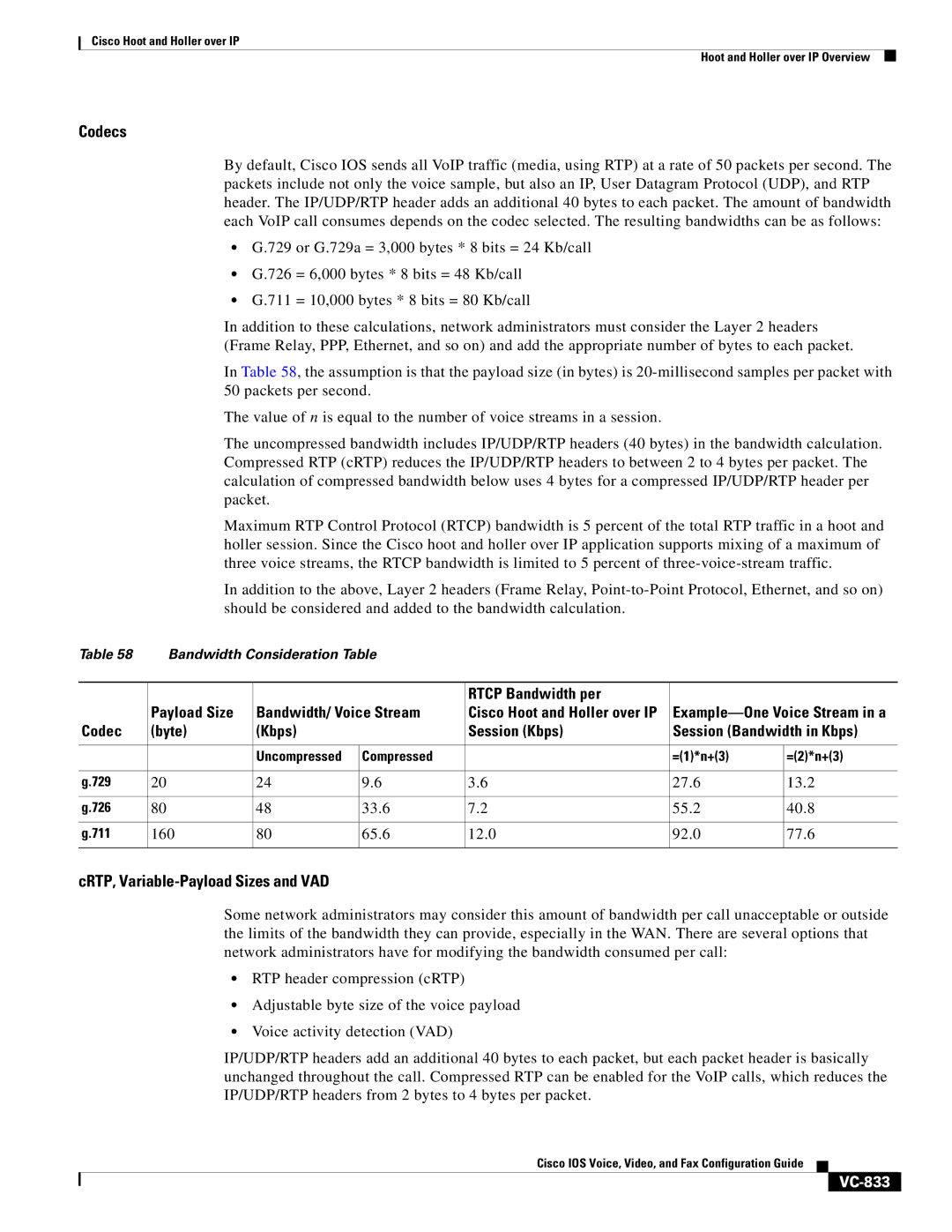
Cisco Hoot and Holler over IP
Hoot and Holler over IP Overview
Codecs
By default, Cisco IOS sends all VoIP traffic (media, using RTP) at a rate of 50 packets per second. The packets include not only the voice sample, but also an IP, User Datagram Protocol (UDP), and RTP header. The IP/UDP/RTP header adds an additional 40 bytes to each packet. The amount of bandwidth each VoIP call consumes depends on the codec selected. The resulting bandwidths can be as follows:
•G.729 or G.729a = 3,000 bytes * 8 bits = 24 Kb/call
•G.726 = 6,000 bytes * 8 bits = 48 Kb/call
•G.711 = 10,000 bytes * 8 bits = 80 Kb/call
In addition to these calculations, network administrators must consider the Layer 2 headers (Frame Relay, PPP, Ethernet, and so on) and add the appropriate number of bytes to each packet.
In Table 58, the assumption is that the payload size (in bytes) is
The value of n is equal to the number of voice streams in a session.
The uncompressed bandwidth includes IP/UDP/RTP headers (40 bytes) in the bandwidth calculation. Compressed RTP (cRTP) reduces the IP/UDP/RTP headers to between 2 to 4 bytes per packet. The calculation of compressed bandwidth below uses 4 bytes for a compressed IP/UDP/RTP header per packet.
Maximum RTP Control Protocol (RTCP) bandwidth is 5 percent of the total RTP traffic in a hoot and holler session. Since the Cisco hoot and holler over IP application supports mixing of a maximum of three voice streams, the RTCP bandwidth is limited to 5 percent of
In addition to the above, Layer 2 headers (Frame Relay,
Table 58 Bandwidth Consideration Table
|
|
|
| RTCP Bandwidth per |
|
|
| Payload Size | Bandwidth/ Voice Stream | Cisco Hoot and Holler over IP | |||
Codec | (byte) | (Kbps) |
| Session (Kbps) | Session (Bandwidth in Kbps) | |
|
|
|
|
|
|
|
|
| Uncompressed | Compressed |
| =(1)*n+(3) | =(2)*n+(3) |
|
|
|
|
|
|
|
g.729 | 20 | 24 | 9.6 | 3.6 | 27.6 | 13.2 |
|
|
|
|
|
|
|
g.726 | 80 | 48 | 33.6 | 7.2 | 55.2 | 40.8 |
|
|
|
|
|
|
|
g.711 | 160 | 80 | 65.6 | 12.0 | 92.0 | 77.6 |
|
|
|
|
|
|
|
cRTP, Variable-Payload Sizes and VAD
Some network administrators may consider this amount of bandwidth per call unacceptable or outside the limits of the bandwidth they can provide, especially in the WAN. There are several options that network administrators have for modifying the bandwidth consumed per call:
•RTP header compression (cRTP)
•Adjustable byte size of the voice payload
•Voice activity detection (VAD)
IP/UDP/RTP headers add an additional 40 bytes to each packet, but each packet header is basically unchanged throughout the call. Compressed RTP can be enabled for the VoIP calls, which reduces the IP/UDP/RTP headers from 2 bytes to 4 bytes per packet.
Cisco IOS Voice, Video, and Fax Configuration Guide
